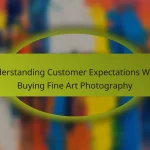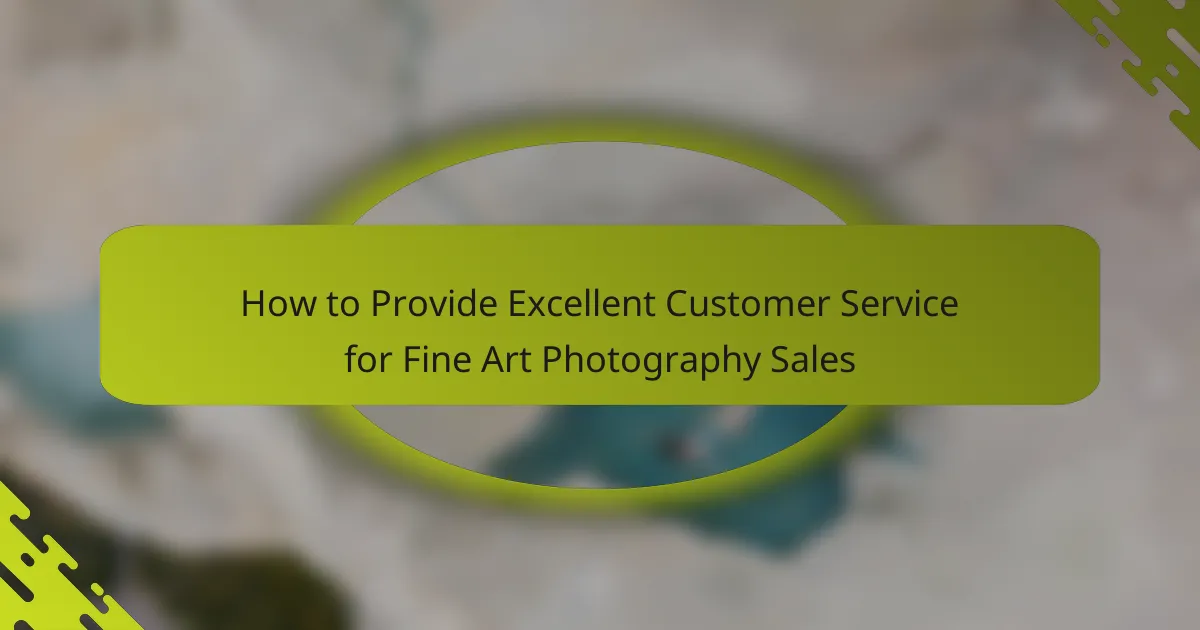When purchasing fine art photography, customers in the US have high expectations for quality, authenticity, and service. They seek exceptional prints with verified provenance, personalized interactions, and transparent return policies to ensure a satisfying experience. Understanding personal taste, the artist’s background, and the emotional impact of the artwork is essential for making informed decisions in this market.
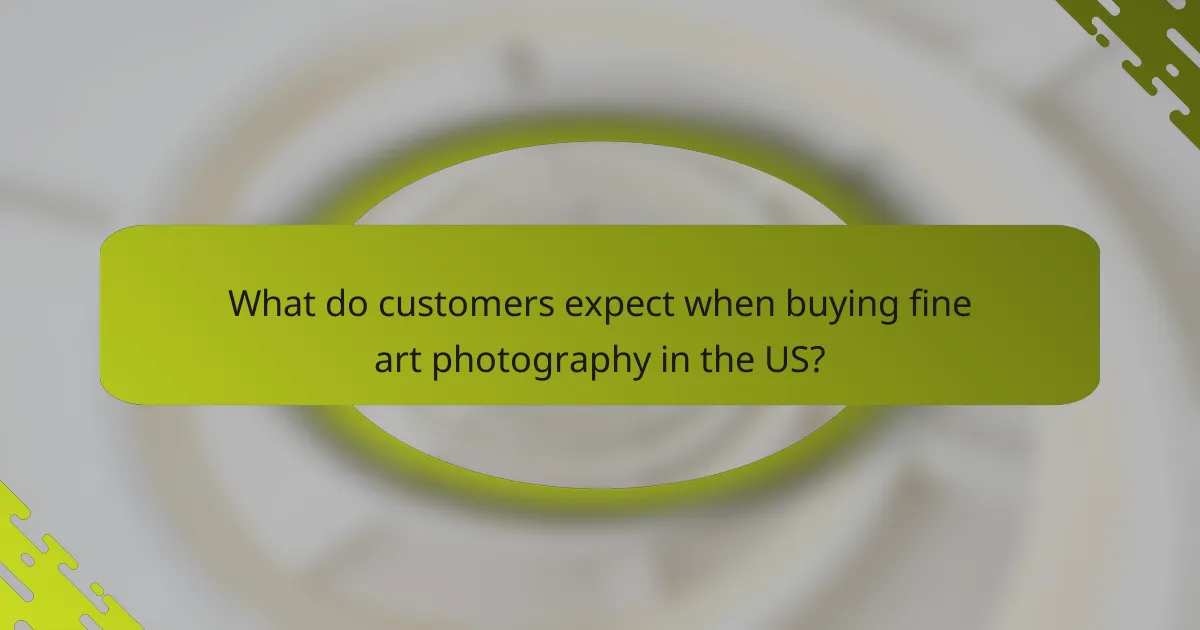
What do customers expect when buying fine art photography in the US?
Customers in the US expect fine art photography to meet high standards of quality, authenticity, and service. They look for exceptional prints, verified provenance, personalized interactions, and clear return policies to ensure a satisfying purchasing experience.
High-quality prints
When purchasing fine art photography, customers expect high-quality prints that accurately represent the artist’s vision. This includes considerations like color accuracy, sharpness, and the choice of materials, such as archival paper or canvas. Buyers often look for prints that are produced using professional-grade printers and inks to ensure longevity.
It’s advisable for customers to inquire about the printing process and check for certifications that indicate the print’s quality. Many artists provide details about the print run, such as limited editions, which can enhance the value and appeal of the artwork.
Authenticity and provenance
Authenticity is crucial in the fine art photography market. Customers expect to receive documentation that verifies the origin and history of the artwork, often referred to as provenance. This may include certificates of authenticity signed by the artist or galleries, detailing the piece’s background and ownership history.
Provenance not only assures buyers of the artwork’s legitimacy but also can significantly affect its value. Customers should request this documentation to ensure they are making a sound investment.
Personalized customer service
Fine art photography buyers often seek a personalized customer service experience. They appreciate when galleries or artists take the time to understand their preferences and provide tailored recommendations. This can include consultations on framing options or advice on how a piece might fit into their existing collection.
Responsive communication is key; customers value prompt answers to their inquiries and a willingness to address any concerns. Establishing a rapport can enhance the overall buying experience and foster customer loyalty.
Clear return policies
Customers expect clear and fair return policies when buying fine art photography. A transparent policy helps buyers feel more secure in their purchase, knowing they have options if the artwork does not meet their expectations. This includes understanding the timeframe for returns and any conditions that may apply.
It’s beneficial for sellers to outline their return process clearly on their website or in purchase agreements. This can include information about shipping costs for returns and whether refunds or exchanges are offered. Clear policies can help build trust and encourage customers to make a purchase.
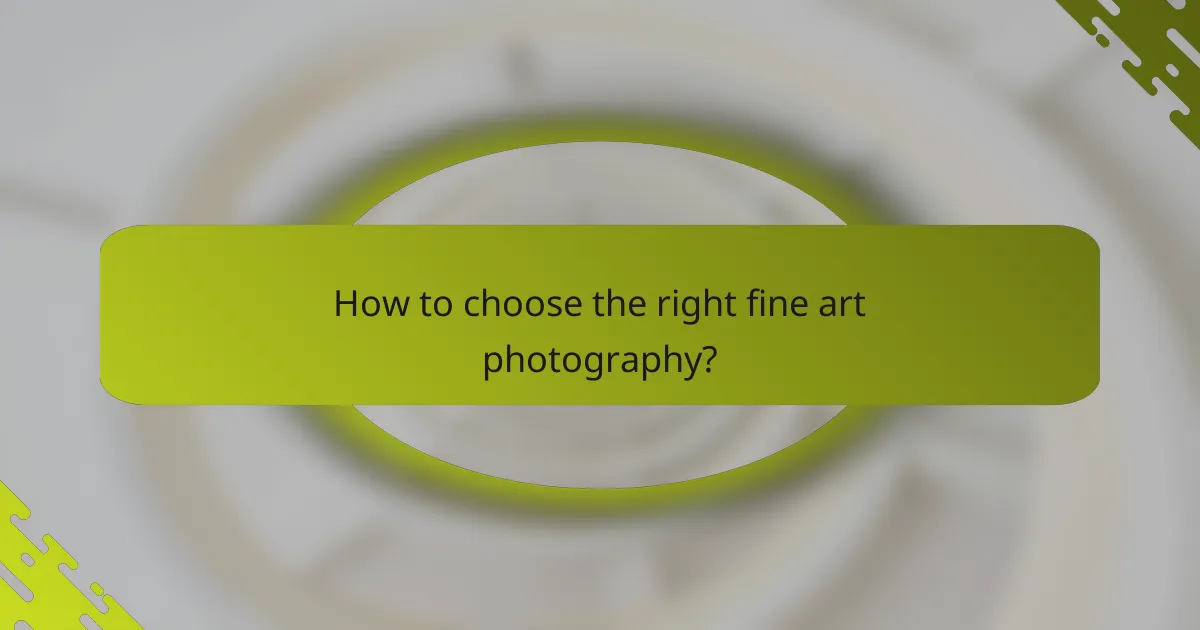
How to choose the right fine art photography?
Choosing the right fine art photography involves understanding your personal taste, the artist’s background, and the emotional resonance of the piece. Consider how the artwork aligns with your aesthetic preferences and the environment where it will be displayed.
Consider the artist’s reputation
The reputation of the artist can significantly influence the value and appeal of fine art photography. Established artists often have a track record of exhibitions and sales, which can enhance the desirability of their work. Research the artist’s background, previous exhibitions, and critical reception to gauge their standing in the art community.
Look for artists who have received awards or recognition, as this can indicate quality and potential investment value. Engaging with galleries or art fairs can also provide insights into emerging talents and established names.
Evaluate the artwork’s emotional impact
The emotional impact of fine art photography is crucial in determining its suitability for your collection. Consider how the piece makes you feel and whether it evokes a strong emotional response. Art that resonates with you personally can enhance your living space and provide lasting enjoyment.
Think about the themes and subjects depicted in the artwork. A photograph that tells a story or captures a moment can create a deeper connection. Take your time to reflect on how different pieces affect you before making a decision.
Assess framing and presentation options
Framing and presentation are essential aspects of displaying fine art photography effectively. The right frame can enhance the artwork’s visual appeal and protect it from damage. Consider materials such as wood or metal, and choose colors that complement the photograph.
Additionally, think about how the piece will be displayed in your space. Options include traditional framing, floating frames, or even mounting on acrylic or aluminum. Ensure that the presentation aligns with your overall decor and enhances the artwork’s impact.
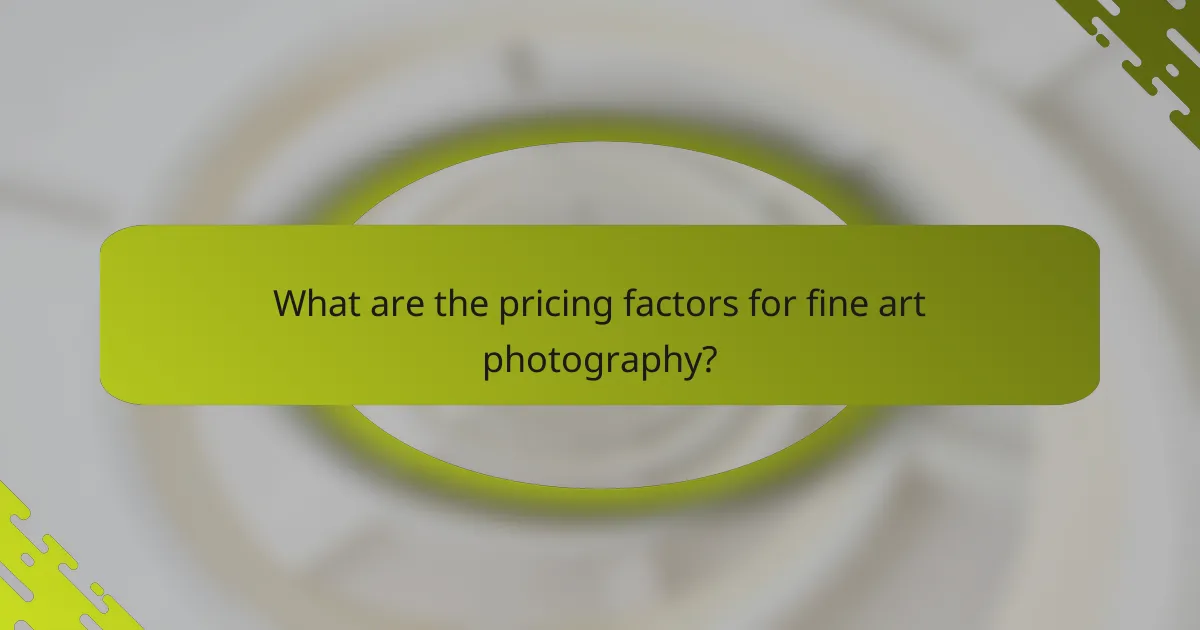
What are the pricing factors for fine art photography?
The pricing of fine art photography is influenced by several key factors, including the artist’s experience, the size and edition of the artwork, and current market demand. Understanding these elements can help buyers make informed decisions and assess the value of a piece.
Artist’s experience and recognition
The experience and recognition of an artist significantly impact the pricing of their fine art photography. Established artists with a strong reputation can command higher prices due to their proven track record and demand in the market.
For example, a well-known photographer with a history of exhibitions and awards may price their work in the thousands of dollars, while emerging artists may offer their pieces at more accessible prices, often in the hundreds.
Size and edition of the artwork
The size of the artwork and whether it is part of a limited edition can greatly affect its price. Larger pieces typically require more resources and time to produce, leading to higher costs. Additionally, limited editions, which restrict the number of prints available, can create a sense of exclusivity that drives up value.
For instance, a large, limited edition print may sell for several thousand dollars, while an open edition smaller print might be priced under a thousand, reflecting the differences in size and scarcity.
Market demand and trends
Market demand and current trends play a crucial role in determining the pricing of fine art photography. As certain styles or themes become popular, prices for those works can increase significantly. Buyers should stay informed about trends to understand potential future value.
For example, if a particular genre, such as abstract photography, gains popularity, works in that category may see a price surge. Conversely, if interest wanes, prices may stabilize or drop, making it essential for buyers to consider timing when purchasing art.

How does shipping affect customer expectations?
Shipping significantly impacts customer expectations by influencing their perception of service quality and product safety. Timely delivery, secure packaging, and insurance options during transit are crucial factors that can enhance or diminish customer satisfaction.
Safe packaging and handling
Safe packaging is essential for fine art photography to prevent damage during transit. Use sturdy materials like reinforced cardboard boxes and bubble wrap to cushion the artwork. Clearly label packages as “fragile” to ensure careful handling by shipping personnel.
Consider using custom packaging solutions that fit the artwork snugly, reducing movement within the box. This attention to detail not only protects the piece but also reflects professionalism, enhancing customer trust.
Shipping timeframes
Shipping timeframes are a critical aspect of customer expectations. Customers typically expect delivery within a few days to a couple of weeks, depending on the shipping method chosen. Offering multiple shipping options can cater to different preferences, from expedited services to standard delivery.
Communicate estimated delivery dates clearly at the time of purchase. Providing tracking information can also help manage expectations and reduce anxiety about the shipment’s status.
Insurance options during transit
Insurance options during transit can greatly influence customer confidence in purchasing fine art photography. Offering insurance protects both the seller and the buyer in case of loss or damage. Many customers expect insurance to be included or available as an add-on during the checkout process.
Clearly outline the insurance coverage options and costs associated with shipping. This transparency helps customers make informed decisions and reassures them that their investment is protected throughout the shipping process.

What role do reviews play in purchasing decisions?
Reviews significantly influence purchasing decisions in the fine art photography market by providing potential buyers with insights into the quality and value of the artwork. Positive testimonials can enhance credibility, while negative feedback may deter potential customers.
Influence of customer testimonials
Customer testimonials serve as powerful endorsements that can sway potential buyers. When previous customers share their satisfaction with a piece of fine art photography, it builds trust and encourages new buyers to consider making a purchase.
For instance, a gallery showcasing a collection of fine art photography may highlight customer reviews on their website or social media. This can include quotes from satisfied clients or ratings that reflect the overall quality of the artwork, which can be particularly persuasive.
Impact of social media presence
A strong social media presence can amplify the impact of reviews by reaching a broader audience. Artists and galleries that actively engage with followers and showcase customer feedback can create a community around their work, making it more appealing to prospective buyers.
Platforms like Instagram and Facebook allow for visual storytelling, where potential buyers can see the artwork in various settings and read real-time reviews. This engagement not only enhances visibility but also fosters a sense of connection, making customers more likely to trust the artist or gallery.
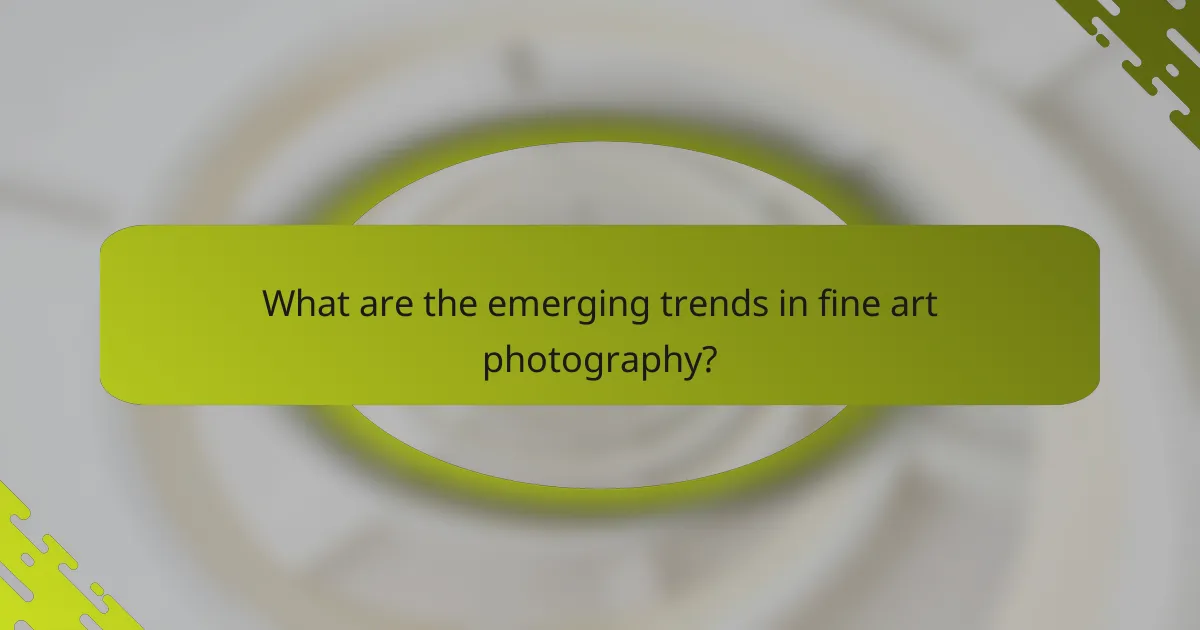
What are the emerging trends in fine art photography?
Emerging trends in fine art photography reflect shifts in technology, consumer preferences, and artistic expression. Key developments include the rise of digital platforms for showcasing art, increased interest in sustainability, and a growing demand for unique, personalized experiences.
Digital Platforms and Online Sales
The proliferation of digital platforms has transformed how fine art photography is marketed and sold. Artists now leverage social media and online galleries to reach a global audience, making it easier for collectors to discover and purchase works from anywhere.
Online sales have become a significant channel, with many galleries and artists reporting that a substantial portion of their sales now occurs through their websites or online marketplaces. This trend emphasizes the importance of having a strong online presence and effective digital marketing strategies.
Sustainability in Art Practices
As environmental concerns grow, many fine art photographers are adopting sustainable practices. This includes using eco-friendly materials, minimizing waste, and supporting local production to reduce carbon footprints.
Collectors are increasingly drawn to artists who prioritize sustainability, often willing to pay a premium for works that align with their values. This trend encourages artists to consider the environmental impact of their work and to communicate their practices to potential buyers.
Personalization and Customization
There is a rising demand for personalized and customized fine art photography. Buyers are looking for unique pieces that resonate with their individual tastes or fit specific spaces in their homes.
Artists can cater to this trend by offering bespoke services, such as commissioned works or tailored prints. Engaging directly with clients to understand their preferences can enhance the buying experience and foster lasting relationships.


